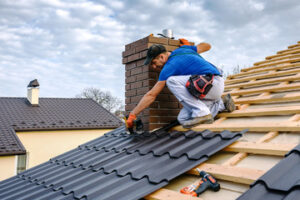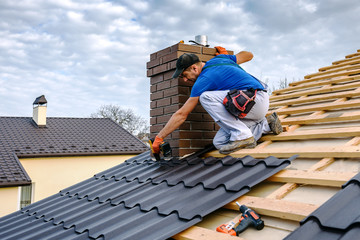You can start a roofing business with a modest investment. You should be able to sell a lot of roofs before you have to spend more on advertising. Promote your business by using social media and branded email blasts. Ask satisfied customers to post reviews on Google and other review platforms.
Roofing materials play an important role in a building’s performance and lifespan. The choice of materials depends on the geographic location, roof shape, and desired look. A variety of roofing materials are available today, including asphalt shingles, membranes, and metal.
Membrane roofing is an affordable option for low-slope and flat roofs. It can be made from a variety of watertight materials, including neoprene, PVC, and EPDM. It is also puncture-resistant and heat-reflective. In addition, it has a lifespan of 20 to 35 years. These materials are durable and can withstand strong winds.
Another type of roofing is corrugated steel. This material is popular in commercial construction and offers good resistance to weathering. It is a cost-effective alternative to traditional roofing systems and is easy to install. It is also resistant to chemicals and bacterial growth, making it a good choice for roofing projects in harsh environments.
Metal roofing feels like a modern choice, but it has been around since the 1800s. It is a versatile choice that comes in both shingle and sheet form. Metal shingles and sheets are designed to look natural, with many options mimicking cedar shake and slate tiles. In addition to their appearance, they have excellent fire resistance and can last up to 80 years.
Clay tile roofing is a common choice for Southwest-style homes. It is available in a wide range of shapes and colors, and it fits well into the style of many residential neighborhoods. While it is expensive, it is extremely durable and lasts for a long time. It is also a good option for high-wind regions.
Other roofing materials include terra cotta and concrete. These are very heavy, but they are also highly durable and watertight. They are installed in much the same way as clay tile, but they can be installed over existing roofing material. They are a great choice for homeowners who want to improve the look of their home, and they are also an eco-friendly choice.
Wood shingles are an economical and attractive roofing material. They are often coated with fire-resistant materials, making them a good choice in high-wind areas. They can also be covered with a layer of plastic to protect against the elements. Other popular roofing materials include rolled roofing, which consists of large rolls of asphalt-impregnated material topped with mineral granules. Rolled roofing is one of the cheapest options and can be installed quickly. It is also available in different thicknesses to suit your climate.
Roofing contractors
Many roofing contractors also offer additional home improvement services, such as window and siding installation. Others specialize in roof repair and replacement only. Choosing the right company for your job will depend on the scope of work, your budget, and other factors. It is important to choose a company that is licensed, insured, and certified. They should also be able to answer any questions you have about their services. In addition, you should look for a company with a good reputation and customer service skills.
In the roofing industry, it’s essential to maintain compliance with state and provincial laws regarding licensing, insurance, and bonding requirements. License requirements vary by jurisdiction, but usually include an examination and verifiable experience in the field. In addition, many roofing professionals are bonded, which protects homeowners from any monetary loss if a contractor fails to complete a project.
Roofing professionals must collaborate with other construction professionals, such as electricians and carpenters, to ensure that all work is completed on time and in the correct sequence. They must also communicate with customers to address their concerns, provide information about roofing materials and techniques, and explain the process of installing a new roof. Often, roofing contractors must work with a limited schedule, so it’s important to be upfront with clients about their availability.
When shopping for a roofing contractor, be sure to get multiple quotes and compare prices, services, and warranties. A quality contractor will work within your budget, but don’t be fooled by the lowest bid. The cheapest price may indicate that the contractor is cutting corners or using inferior materials.
The Roofing Contractors industry faces significant challenges, including regulatory changes and political pressures. NRCA’s advocacy team works to unite the industry to speak with one voice in Washington, DC, and in state capitals. They do this through grassroots efforts, national fly-in advocacy days, and by leveraging ROOFPAC to leverage resources from other industry groups. They also communicate with policymakers via NRCA’s technical publications, For Members Only newsletter, and industry issue updates. These efforts help to minimize risks and improve the overall quality of the roofing industry.
Roofing jobs
Roofing jobs can include installing new roofs, repairing old ones, or replacing existing shingles and tiles. Other tasks may involve sealing gutters, chimneys, walls, and vents. Roofing contractors may also need to work with other tradesmen to complete these projects. Depending on the scope of the job, some roofing companies offer a variety of additional services, such as removing and installing insulation and vapor barriers. These tasks can require a large amount of physical labor. Roofing contractors should also have the proper tools to perform these tasks safely.
Starting a roofing business requires a lot of planning, including legal processes and bookkeeping. These issues may seem intimidating to new entrepreneurs, but there are many online resources and local businesses that can provide advice and help. The legal process of starting a company includes deciding on the type of entity (sole proprietorship, partnership, LLC or corporation) and registering with the appropriate authorities. You will also need to obtain a contractor’s license, required permits, and zoning inspections. You should also set up a separate bank account and open a credit card for the business.
Another key consideration is the type of equipment you’ll need. Buying brand-new equipment can be expensive, so you should choose carefully. A well-signed truck with a big name and phone number is a must, and you should consider using a free website to promote your business. You can also use social media, a branded email blast, and newsletters to spread the word about your business.
Another important task is to keep your roofing project on schedule. This can be challenging, especially if you have several projects in progress at once. Fortunately, new technology like iRoofing can help you stay on track. This roofing software gives office administrators instant access to each client being served and the status of their job. It can even send alerts to workers when they need to get on site early. This will help you deliver quality projects on time and ensure that your workers are being paid for their work. In addition, it will help you monitor your overhead costs.


